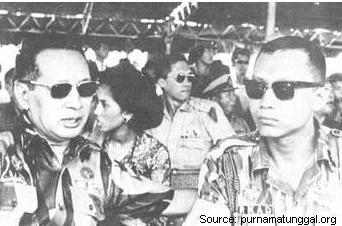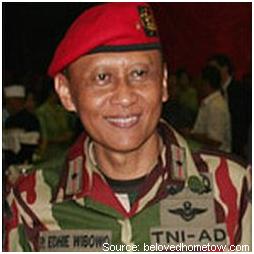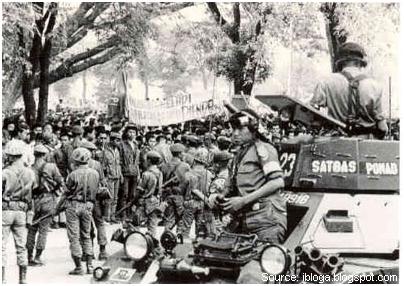Early in the morning on October 1st, 1965, Colonel Sarwo Edhie Wibowo, the commander of the Para-commando Brigade (RPKAD), held a briefing with his deputy Major C. I. Santosa, about the radio broadcast announcing the establishment of the obscured September 30 Movement (G30S) led by Lieutenant Colonel Untung a). While they were puzzling about the declaration, Captain Herman Sarens came in driving a panzer submitting a note from General Soeharto: “The situation is very critical. I, therefore, take over the Army Command in Chief. Try to meet me soon.”
Suspecting that Sarens could be the proponent of the movement, Sarwo Edhie didn’t want to take the risk and arrested him immediately. He sent, instead, his aide Captain Daryono to meet General Soeharto at the headquarters of the Army Strategic Command (Kostrad), located at the eastern side of Merdeka (now National Monument) Square, to get the whole picture of the situation. Having got the information, Sarwo Edhie released Sarens.
As Sarwo Edhie met Soeharto in Kostrad Headquarter at the afternoon, they immediately set a plan to attack the movement. At dusk Sarwo’s troops took over the telecommunication building and the radio station (RRI) at the western side of Merdeka Square which then were at the hands of PKI, without even firing a single bullet. At everybody surprise, such vital buildings were found to be abandoned by the pro-PKI troops who supposed to guard the buildings and now only a couple of Pemuda Rakyat who guarded them. What the paracommando troops had done to deter them was just threw their red berets upon which the guards put down their guns.
 Meanwhile, parts of the 530 and 545/Brawijaya Battalions which were under the influence of G30S then posted in Merdeka Square, under Soeharto approach moved to Kostrad headquarter, while the rest left to Halim Airbase. They were found to be running out of provisions which the movement organizer seemed to “forget” supplying them b).
Meanwhile, parts of the 530 and 545/Brawijaya Battalions which were under the influence of G30S then posted in Merdeka Square, under Soeharto approach moved to Kostrad headquarter, while the rest left to Halim Airbase. They were found to be running out of provisions which the movement organizer seemed to “forget” supplying them b).In the middle of the night when Soeharto was thinking about the next step, Sarwo suddenly appeared and asked for the plan to attack Halim Airbase. General Nasution, who sat in a chair and put one of his pain legs on the table smilingly commented: “Sarwo, you want to make the second Mapanget?” c) Soeharto agreed and ordered Sarwo to immediately launch such an offensive operation.
In fact, larger parts of Brawijaya Battalions who fled to Halim took the defense position there. The G30S Central Command was also posted in one of the Air Force officers’ house in Halim, at the same time as Admiral Omar Dhani, the Air Force Chief of Staff, who occupied the Operation Command room. Aidit and his aides followed suit posted in Halim joining President Sukarno, who had already there in the morning. First Lieutenant Dul Arief and his kidnapper troops posted just close by, in a rubber plantation called Lubang Buaya where Pemuda Rakyat and Gerwani tortured and killed the kidnapped generals.
 Major C.I. Santosa, having an order to prevent the Air Force airplanes to take off for bombing the strategic points, led the paracommando troops to ambush Halim Airbase. When a fierce battle had broken out for a while, suddenly a jeep waving a white flag came from the opposite direction with Commodore Dewanto inside.
Major C.I. Santosa, having an order to prevent the Air Force airplanes to take off for bombing the strategic points, led the paracommando troops to ambush Halim Airbase. When a fierce battle had broken out for a while, suddenly a jeep waving a white flag came from the opposite direction with Commodore Dewanto inside.Dewanto insisted to have a ceasefire, which Sarwo refused saying that his troops were subject to the supreme leader. Under Dewanto’s suggestion, they finally agreed to meet Real Admiral Sri Mulyono Herlambang who told them that President Soekarno wished the same thing. Using helicopters, all of them headed to Bogor Palace to meet the President who had left Halim earlier.
Soekarno explained them that the current Armed Forces Supreme Commander was in his hand. He added that what happened to the late Army generals was just like a ripple in the middle of the ocean waves of revolution.
Sarwo informed Soekarno that the 545-Brawijaya Battalion Commander was only willing to lay down the weapons if there was an order from the President. Soekarno asked his aide Brigadier General Sabur to prepare a memorandum ordering Brigadier General Supardjo, then acted as G30S Deputy Commander to ceasefire.
Colonel Sarwo could not believe in what Soekarno had just said. Sarwo was disappointed with Sukarno words on the fate of the late generals whom he respected so much. Upon Sarwo’s question about the Army hierarchy that Sukarno failed to observe, Sukarno responded that the hierarchy was unimportant considering that Supardjo was at that time the commander of the whole troops in Halim.
Under the truce, some companies of the 454-Battalion surrendered while the rest fled away to outside Jakarta. When the surrendered companies realized that their opponent leader was no one but Sarwo Edhie, their former instructor, they looked surprised and hugged each other.
The meeting of the leaders of the confronting troops with Soekarno in Bogor Palace was unique. It was also decisive as the fate of the G30S movement and PKI existence was determined in that meeting. The accord minimized the casualties of the battle The balance was minor i.e. one para-commando and two Air Force soldiers had been killed during the battle.
Notes:
a. The commander of Cakrabirawa, the President and Palace guardian regiment.
b. The short of provisions was not happened on the troops who posted in Merdeka Square but all troops who posted everywhere in strategic places including those who guarded the telecommunication building and radio station.
c. Nasution had just a sprained leg resulted from jumping over the wall under the fires of the kidnappers the night before. He remembered about Sarwo Edhie’s successful attack in taking over Mapanget Airbase against Permesta, a regional rebellion occured in North Sulawesi several years before.

No comments:
Post a Comment